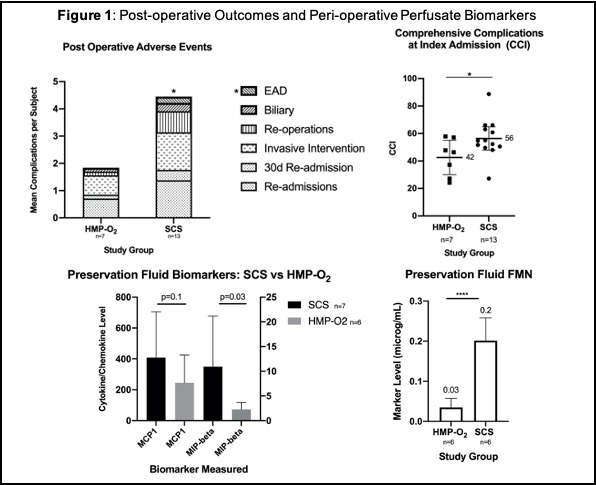Hypothermic Oxygenated Machine Perfusion Protects Against Cholangiocyte and Hepatocyte Injury and Mitigates Inflammation vs Static Cold Storage: Preliminary Results from a Single Center
Transplant Surgery, Rutgers NJMS, Newark, NJ
Meeting: 2021 American Transplant Congress
Abstract number: 113
Keywords: Bile duct, Immune deviation, Ischemia, Liver preservation
Topic: Clinical Science » Biomarkers, Immune Assessment and Clinical Outcomes
Session Information
Session Name: Biomarkers, Immune Assessment and Clinical Outcomes - II
Session Type: Rapid Fire Oral Abstract
Date: Sunday, June 6, 2021
Session Time: 4:30pm-5:30pm
 Presentation Time: 4:40pm-4:45pm
Presentation Time: 4:40pm-4:45pm
Location: Virtual
*Purpose: Hypothermic-oxygenated machine perfusion (HMP-O2) is a promising preservation technique with potential to mitigate ischemia/reperfusion injury and improve graft and patient outcomes. Here we present preliminary results from a single center within the PILOT trial (NCT03484455), a prospective, multi-center randomized controlled trial comparing HMP-O2 to Static Cold Storage (SCS), using the LifePort Liver Transporter (Organ Recover Systems, Itasca, IL).
*Methods: 13 SCS and 7 HMP-O2 cases were analyzed over a median of 10mo. Preservation fluid samples were serially collected during HMP-O2 and after flush for SCS to normalize for volume of distribution. Liver and bile duct biopsies and bile fluid were collected 1hr post reperfusion. Bile analysis was performed via the iSTAT-1/CG8+ system. Preservation and bile fluid cytokine/chemokine levels were measured by Luminex (Millipore). Preservation fluid FMN, a known predictive biomarker for poor outcomes post-transplant, was measured via fluorescence absorbance. A p<0.05 was considered significant.
*Results: Donor and recipient characteristics were similar between groups. Cold time was longer for HMP-O2 vs SCS (6.9 vs 5.4hrs, p<0.01). RBC utilization was greater following SCS vs HMP-O2 (14 vs 7 units, p=0.05). Overall patient and graft survival was 100% for both. Patients experienced more immediate complications and more long-term post-operative adverse events after SCS vs HMP-O2 (Comprehensive Complication Index, CCI, 56 vs 42, p<0.05), Figure 1. Post-reperfusion cholangiocyte injury was mitigated by perfusion, as reflected by higher bile glucose in SCS cases (156 vs 55 mg/dL, p<0.05). Biliary and acute liver injury-associated chemokine MIP-1β (2 vs 10 pg/mL, p<0.05) and perfusate FMN (0.03 vs 0.2 µg/mL, p<0.001) were significantly lower in preservation fluid following HMP-O2 vs SCS, Figure 1. These markers correlate with improved post-operative graft function and decreased acute liver injury following transplant.
*Conclusions: HMP-O2 appears to be a safe and effective preservation method. Preliminary results demonstrate improved short-term outcomes, improved inflammatory profile, and better early graft function. Biomarkers in perfusate may provide targets for future intervention in efforts to mitigate IRI, expand the liver donor organ pool, and improve long-term patient outcomes. Further study is needed to fully characterize the benefits of HMP-O2 in liver transplantation.
To cite this abstract in AMA style:
Panayotova G, Paterno F, McCarty M, Dikdan G, Simonishvili S, Qin Y, Brown L, Amin A, Lunsford KE, Guarrera JV. Hypothermic Oxygenated Machine Perfusion Protects Against Cholangiocyte and Hepatocyte Injury and Mitigates Inflammation vs Static Cold Storage: Preliminary Results from a Single Center [abstract]. Am J Transplant. 2021; 21 (suppl 3). https://atcmeetingabstracts.com/abstract/hypothermic-oxygenated-machine-perfusion-protects-against-cholangiocyte-and-hepatocyte-injury-and-mitigates-inflammation-vs-static-cold-storage-preliminary-results-from-a-single-center/. Accessed December 15, 2025.« Back to 2021 American Transplant Congress

